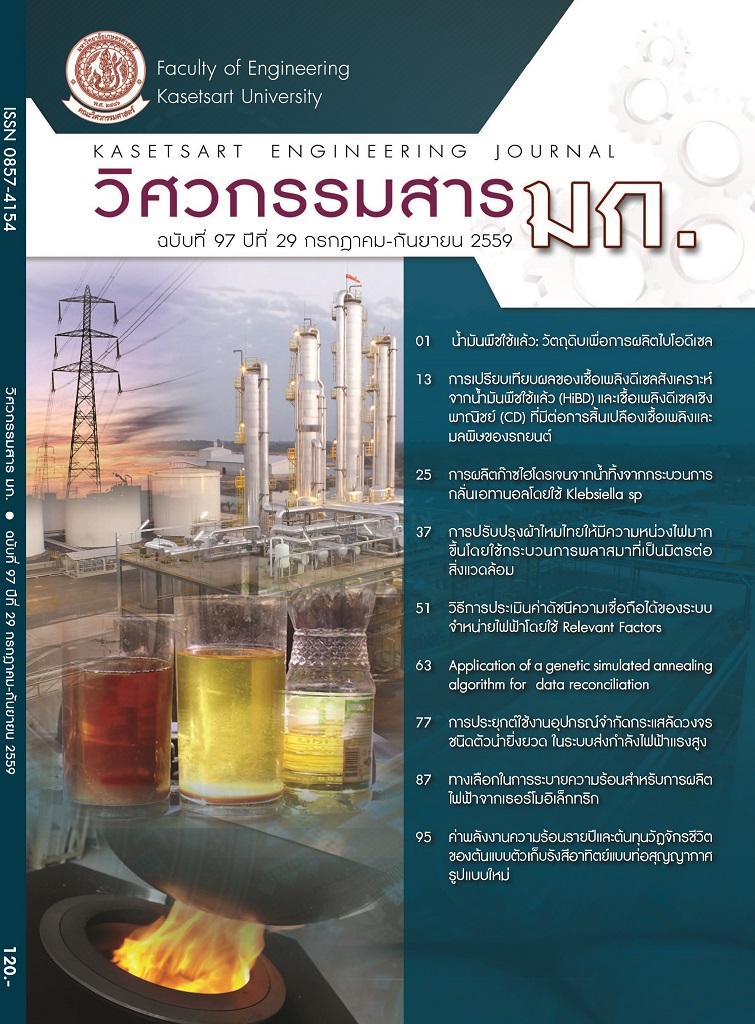การผลิตก๊าซไฮโดรเจนจากน้ำทิ้งจากกระบวนการกลั่นเอทานอลโดยใช้ Klebsiella sp.
Keywords:
การผลิตก๊าซไฮโดรเจน, เคลบเซลลา, น้ำทิ้งจากการกลั่นเอทานอล, hydrogen production, Klebsiella sp, ethanol whole stillage waterAbstract
การใช้น้ำทิ้งจากกระบวนการกลั่นเอทานอลในการผลิตก๊าซไฮโดรเจนโดย Klebsiella sp. เตรียมน้ำทิ้ง โดยนึ่งฆ่าเชื้อที่อุณหภูมิ 121°C เป็นเวลา 15 นาที การผลิตไฮโดรเจนของ Klebsiella sp. ได้ศึกษาการหมักก๊าซไฮโดรเจนแบบกะ ซึ่งศึกษาสภาวะที่เหมาะสมในการหมัก คือ ความเข้มข้นของน้ำตาล ค่าพีเอช และปริมาณไนโตรเจนเริ่มต้น พบว่า สภาวะที่สามารถผลิตก๊าซไฮโดรเจนได้สูงสุดคือ ที่อุณหภูมิ 30 °C ความเข้มข้นของน้ำตาลเริ่มต้น 2 °Brix ค่าพีเอชเริ่มต้น 6 และความเข้มข้นเริ่มต้นของไนโตรเจน 3 g/L ของไดแอมโมเนียมฟอสเฟตนำสภาวะที่เหมาะสมดังกล่าวมาใช้ผลิตก๊าซไฮโดรเจนและติดตามการเปลี่ยนแปลงของสารเมตาบอไลท์ระหว่างกระบวนการหมัก พบว่า ผลผลิตก๊าซไฮโดรเจนสูงสุด คือ 154.46 mgH2/L ที่เวลา 48 ชั่วโมง และการสะสมก๊าซไฮโดรเจนทั้งหมด คือ 402.34 mgH2/L ที่เวลา 72 ชั่วโมง ส่วนการเปลี่ยนแปลงสารเมตาบอไลท์ระหว่างกระบวนการหมักก๊าซไฮโดรเจน จะเห็นได้ว่า ปริมาณน้ำตาลรีดิวซ์ ปริมาณน้ำตาลทั้งหมด ค่าพีเอช และค่าซีโอดีลดลงตลอดการหมัก ในทางตรงกันข้าม ปริมาณกรดไขมันระเหยง่ายทั้งหมดและปริมาณไนโตรเจนทั้งหมดลดลงจากผลการทดลองชี้ให้เห็นได้ว่า เชื้อ Klebsiella sp. สามารถนำมาผลิตไฮโดรเจนโดยใช้น้ำทิ้งจากกระบวนการกลั่นเอทานอลได้ดี
Hydrogen production from ethanol whole stillage water using Klebsiella sp.
Ethanol whole stillage water (EWSW) was used as a substrate for hydrogen production by Klebsiella sp. It was heated in an autoclave at 121 °C for 15 min. Hydrogen production by Klebsiella sp. was studied in batch cultivation. Various fermentation conditions (sugar concentrations, initial pH values and nitrogen contents) were evaluated for hydrogen production. Maximal hydrogen yield was obtained at 30 °C with a sugar concentration of 2 °Brix, initial pH value of 6 and a nitrogen concentration of 3 g/L as diammonium phosphate. This optimal condition was used for hydrogen production. The results showed that the maximum hydrogen yield and cumulative hydrogen production were 154.46 mg H2/L after 48 h and 402.34 mg H2/L after 72 h, respectively. The metabolite concentrations changed during hydrogen production. Reducing sugars, total sugars, pH and COD decreased while TVFA and total nitrogen concentrations decreased. These results indicate that Klebsiella sp. is a good hydrogen producer using EWSW as a substrate.


